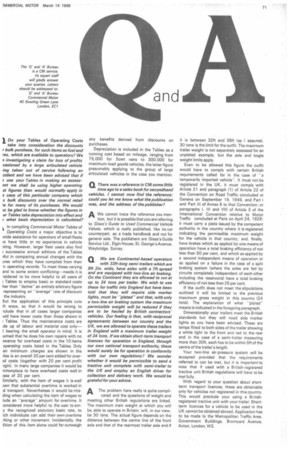I Do your Tables of Operating Costs take into consideration the
Page 73

If you've noticed an error in this article please click here to report it so we can fix it.
discounts r bulk purchase, for such items as fuel and res, which are available to operators? We a investigating a claim for loss of profits casioned by a large articulated vehicle ,ing taken out of service following an cident and we have been advised that if ? use your Tables in making an assessant we shall be using higher operating st figures than would normally apply in 9 case of this particular company which
s bulk discounts over the normal retail %a for many of its purchases. We would to be glad to know whether the figures in ur Tables take depreciation into effect and a what basis depreciation is calculated?
k In compiling Commercial Motor Tables of
Operating Costs a major objective is to )vide assistance for operators of small fleets io have little or no experience in vehicle ;ting. However, larger fleet users also find successive annual editions of the Tables .ful in comparing annual changes with the ures which they have compiled from their n operating records. To meet these varying and to some extent conflicting—needs it is isidered to be more helpful to all users of Tables to employ basic or standard costs her than "derive" an entirely arbitrary figure representing an "average" rate of discount the industry.
3ut the application of this principle cuts :h ways, so that it would be wrong to lclude that in all cases larger 'companies luld have lower costs than those shown in Tables. Thus the maintenance costs are de up of labour and material cost only! bearing the small operator in mind. It is iumed that he does his own repairs with no mance for overhead costs in the 10 items operating casts listed in the Tables. Only en minimum charges are shown in the ples is an overall 20 per cent added for overad costs (together with 20 per cent profit rgin). In many large companies it would be nmonplace to have overhead costs well in :ess of 20 per cent.
similarly, with the item of wages it is well )wn that substantial overtime is worked in d transport. Nevertheless it would be misding when calculating the item of wages to lude an "averageamount for overtime. It 3onsidered more helpful to the user to emy the recognized statutory basic rate, to ich individuals can add their own overtime rking or other increment. Incidentally, the iition of this item alone could far outweigh
any benefits derived from discounts on purchases.
Depreciation is included in the Tables as a running cost based on mileage, ranging from 75,000 for 5cwt vans to 300,000 for maximum-load goods vehicles, the latter figure presumably applying to the group of large articulated vehicles in the case you mention.




















































































































